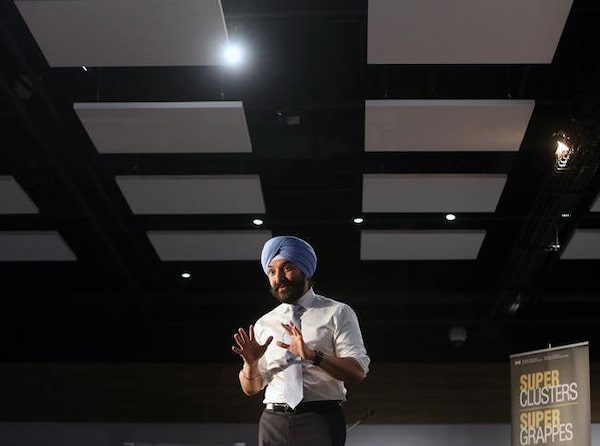
Navdeep Bains, Minister of Innovation, Science and Economic Development, announces proposals under the $950-million Innovation Superclusters Initiative in Ottawa, on Feb. 15, 2018.
The federal industry department spent $1-billion less than planned in the past fiscal year, largely because of a delay in spending for innovation programs, new figures show.
The Department of Innovation, Science and Industry’s annual results report, tabled in the House of Commons last week, indicates that only about $2.3-billion of the department’s $3.3-billion budget was spent in the 2018-19 year. The report said the money that had been budgeted for programs such as Connect to Innovate and the Superclusters Initiative could be spent in future years.
The Superclusters program, which aims to create five business-and-research consortiums across Canada, was announced in the 2017 budget, but has been among the slowest spenders. The Public Accounts show the initiative had a $244-million budget in 2018-19, but had spent only $5.6-million. Connect to Innovate, which aims to bring high-speed internet to more rural communities, spent $68-million of its $249-million budget.
Jim Hinton, an intellectual-property lawyer in Waterloo, Ont., said the government has been slow to close deals with companies that have applied for the funding, and that has made it hard for technology companies to plan.
“The pace of innovation works a lot faster than governmental budget cycles," he said.
Mr. Hinton said that, for the most part, only large foreign-owned companies can afford to wait three to five years without getting the funding. And for the companies that do get the money, he said, it usually supports “add-ons" and not the main business line.
“You have your core investors, and this other [funding] is non-core. And if it hits and it works, then it’s good, and if it doesn’t, then it doesn’t kill your business,” he said.
He said the delays in reaching funding agreements are due to a misalignment between the outcomes the government wants and what the companies are planning. For instance, the government may want an exact number of jobs created, while a recipient’s goals are to create intellectual property.
The federal government declined to explain the unspent funds for innovation programs.
Veronique Simard, a spokesperson for Innovation Minister Navdeep Bains, said funds can be reprofiled for future years for a variety of reasons, including a high volume of applications or more time required to negotiate contribution agreements.
Conservative MP Michelle Rempel Garner, her party’s industry critic, said the delays indicate larger problems with the innovation agenda’s design. She said the Liberal government has been too focused on making lavish announcements with promises of large cheques to hand out, and not on the real outcomes for the companies.
“There’s this school of thought in Canada that if we just spend enough money, then somehow we’re going to be able to commercialize our research and retain the [intellectual property]," she said. "That really hasn’t borne fruit.”
The Parliamentary Budget Officer has begun to assess the Superclusters program. Ms. Rempel Garner, who worked in the University of Manitoba’s technology commercialization office before entering politics, had asked the budget watchdog to look into the program’s spending, how many jobs it created and whether the intellectual property it produced would remain in Canada.
A study released last year by the Institute for Research on Public Policy showed Canadian inventors were more likely to license their intellectual property to foreign companies rather than use it themselves to bring products to market.
Your time is valuable. Have the Top Business Headlines newsletter conveniently delivered to your inbox in the morning or evening. Sign up today.
 Chris Hannay
Chris Hannay